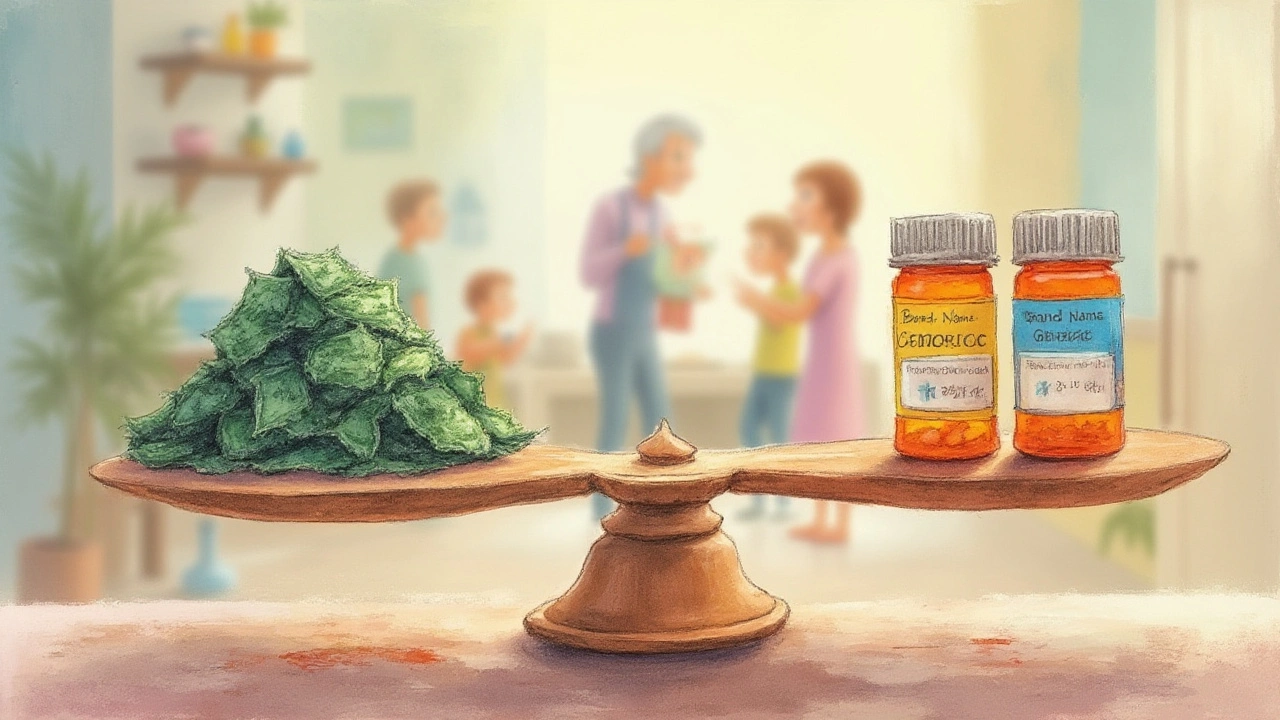Walk into any pharmacy, and you’ll spot two kinds of pills with almost identical labels—but wildly different price tags. The pharmacist might ask: “Would you prefer the brand or the generic?” You hesitate. Is the cheaper one as good? Is the expensive one worth it? You’re not alone. For decades, these questions have sparked heated debates in doctors’ offices, family kitchens, and on late night talk shows. But despite all the buzz, most of what people believe about brand-name and generic drugs is just plain wrong. Let’s pull back the curtain on what’s really going on in those little bottles, the big money at stake, and the ways you can use this info to get better care—without draining your savings.
What Actually Sets Brand-Name and Generic Drugs Apart?
The science here is a lot less mysterious than you’d think. Both brand-name and generic drugs contain the same active ingredients, meaning the compound that actually does the work in your body. The U.S. Food and Drug Administration (FDA) runs both types through a rigorous approval process, demanding that generics work the same way and deliver the same results as their branded twins. That’s why, when you take a generic ibuprofen, your headache fades away at basically the same speed as it would with a Motrin. You might be wondering: if the pills work the same, why do people obsess over the differences? One answer is marketing. Brand-name drugs start with years of research, splashy ads, and sometimes celebrity endorsements. When a company discovers a new treatment, it scores a patent that locks out competition for up to 20 years. During that time, the maker sets sky-high prices to make back the billions spent on development and marketing—but when the patent expires, other companies can finally make a generic copy. They skip all the early research costs, which is a huge part of why generics cost less. They don’t need to invent a brand-new medicine, just prove they can make a safe copy. According to a 2020 FDA report, generics make up 90% of prescriptions filled in the U.S. but only account for about 22% of total drug costs. Brand names? They rake in the rest—and that’s a multi-billion dollar gap.
But here’s the catch: while the active ingredient is identical, generics and their branded rivals can have different inactive ingredients, like coloring or fillers. These usually don’t change how the medicine works, but there are exceptions. For folks with allergies—say, to a certain dye or preservative—those differences matter. Sometimes, a change in coating or how quickly the pill dissolves makes a noticeable difference for patients with extra-sensitive stomachs or who need extended-release medication. If something feels off when you switch from brand-name to generic (or even from one generic to another) talk to your doctor or pharmacist. Pharmacies sometimes switch suppliers based on cost, so your ‘usual’ generic might look different depending on where you shop or even the time of year. Pay close attention if your medicine has a ‘narrow therapeutic index’—that’s science talk for drugs where even a small change in dose can make a big difference, like certain heart medications or thyroid pills. For those, people might notice a switch more easily.
It’s also worth noting: both types must meet the same FDA standards for purity, potency, and manufacturing, but brand-name drugs sometimes carry more data from those expensive clinical trials. It’s not that they’re safer, but there’s more research out there for super-rare side effects before any generics launch. Generics jump in with what’s called bioequivalence studies—proving their product delivers the drug into your bloodstream at the same rate and amount as the original. In a 2017 FDA study, 95% of generics tested matched their brand-name versions within just a 3.5% margin of error for medication absorption. For most people, that’s close enough to be medically identical, but it matters more for complex, slow-release meds, especially for chronic conditions.

Costs, Insurance, and How Drug Prices Shape Your Choices
If you’ve ever felt sticker shock picking up a prescription, you’re not imagining things. Drug pricing in America could fill a season of its own on reality TV—it’s so unpredictable that the price can double, even triple, from one pharmacy to the next, and it often varies by insurance plan or with generic availability. Here’s how it works: when a brand-name drug first hits the market under patent, it’s protected from competition and the company sets the price as high as people—and health plans—are willing to pay. Some drugs launch at monthly prices above $1000. Once that patent ends, a flood of generic versions pops up, and the price can nosedive by up to 80-90%. A 2021 AARP report found the average brand-name prescription filled in the U.S. that year cost $353, compared to just $27 for the typical generic. That's not just chump change—switching from brand to generic could save a family hundreds or even thousands each year without sacrificing health.
Your insurance company has a big say in what you pay. Most plans steer you toward generics because it saves everyone money. Ever had a doctor write a prescription and your pharmacy or insurance tells you only the generic is covered? They’re not just being difficult—they’re following a cost-saving formula. If you insist on the brand, you’ll pay more out of pocket, sometimes double or triple, especially if your insurer puts it in a premium pricing tier. There are rare exceptions: if your doctor writes “DAW” (dispense as written) because of a medical need, some plans will cover the brand-name drug, but often you’ll still pay more. Some big pharmacy chains and warehouse clubs even offer a list of generic meds for as little as $4 for a month’s supply. That’s often less than your insurance copay, especially for common meds like blood pressure pills or antibiotics. Here’s a tip: always ask your pharmacist if paying cash for a generic is cheaper than using your insurance. Weirdly, sometimes it is. There are even discount apps or manufacturer coupons that can slash your costs, so don’t be afraid to shop around.
Some patients feel stuck paying more for brands because of loyalty or stories about bad experiences with generics. But in large studies, switching to a generic hardly ever results in a noticeable loss of effectiveness; the only exceptions are rare cases tied to specific medications, like some seizure drugs or critical thyroid hormones. Even then, it’s often just a matter of adjusting the dose. The vast majority of people have no issues switching, and doctors and pharmacists regularly recommend generics as safe, reliable options. Here’s a peek at how those savings add up:
| Medication | Brand-Name Monthly Cost | Generic Monthly Cost | Annual Savings (Approx.) |
|---|---|---|---|
| Lipitor (cholesterol) | $120 | $10 | $1,320 |
| Prozac (antidepressant) | $110 | $8 | $1,224 |
| Singulair (asthma) | $250 | $15 | $2,820 |
| Advair (inhaler) | $350 | $60 | $3,480 |
If you see a huge difference in price and aren’t sure your generic is truly equivalent, ask your pharmacist to look up the manufacturer’s name. Sometimes, certain brands of generics become fan favorites for consistent quality—it's not all the same as one factory overseas. This can matter for people sensitive to even minor changes. If you know a particular generic works for you, you can ask your pharmacy to keep stocking that version. The way your medication actually gets to the shelves is a whole world of supply deals and contracts most customers never see.

Practical Advice: How to Choose, What to Watch For, and Smarter Questions to Ask
Still not sure what to pick when offered the choice? Here are a few easy steps to make medication decisions that are truly best for your health and your wallet.
- Start by asking your doctor if a generic is available. Most write prescriptions for generics by default for common conditions. But for new drugs or unfamiliar treatments, check if a generic substitute exists, or when it’s set to launch.
- Get to know your insurance plan’s drug coverage. The difference between a $10 and $100 copay can be huge. Scan your plan’s "formulary" (drug list), or ask a pharmacist what’s preferred.
- Always compare cash price vs. insurance price, especially for older drugs. Pharmacists can look this up instantly and aren’t paid to favor one over the other.
- If you have allergies or have had trouble with a generic before, mention it. Doctors can note a specific brand in your chart, or suggest another generic from a different supplier.
- Don’t ignore changes in how you feel after switching between versions—even minor side effects could be due to a different inactive ingredient. If anything seems off, check in with your healthcare provider right away.
- For drugs with a narrow therapeutic index, like some seizure or heart medicines, ask about consistent refills from the same manufacturer. Some pharmacies will note this preference in your file.
- Ask your doctor to explain why they recommend a brand-name if it’s much more expensive. Sometimes it’s about patient experience or absorption rates; sometimes it’s just “how things have always been done.”
- Research options for assistance programs if your required medication doesn’t have a generic. Some manufacturers and nonprofits offer discounts or even free meds if you qualify.
And don’t be swayed by looks. Generics can come in different shapes and colors, even for the same dose. While it might feel unsettling if your weekly pill goes from orange to blue, it’s almost always just aesthetics. If you want consistency (or just don’t like surprises), some pharmacies let you request the same manufacturer for each refill.
You might even discover that for certain chronic illnesses where names like Humira or Eliquis get tossed around, biosimilars (a special category of generic for complex biologic drugs) are now available. These aren’t exact copies, but the FDA says they perform “similarly with no meaningful clinical differences.” A lot of the old rules about generics are now being re-written as these biosimilars start to chip away at some of the costliest corners of modern medicine. That’s good news if you’re dealing with conditions like rheumatoid arthritis or certain cancers, where a brand-only drug could otherwise wipe out your savings.
If you make just one change after reading this, it’s this: every time you fill a prescription generic drugs are almost always the smarter first choice, unless there’s a clear reason not to. That’s what doctors, pharmacists, and most major health organizations do themselves when they need medicine. But if something doesn’t feel right, trust your instincts. Medicine is personal, and you deserve options that work well for you—without mystery or guilt about the price tag.


Write a comment